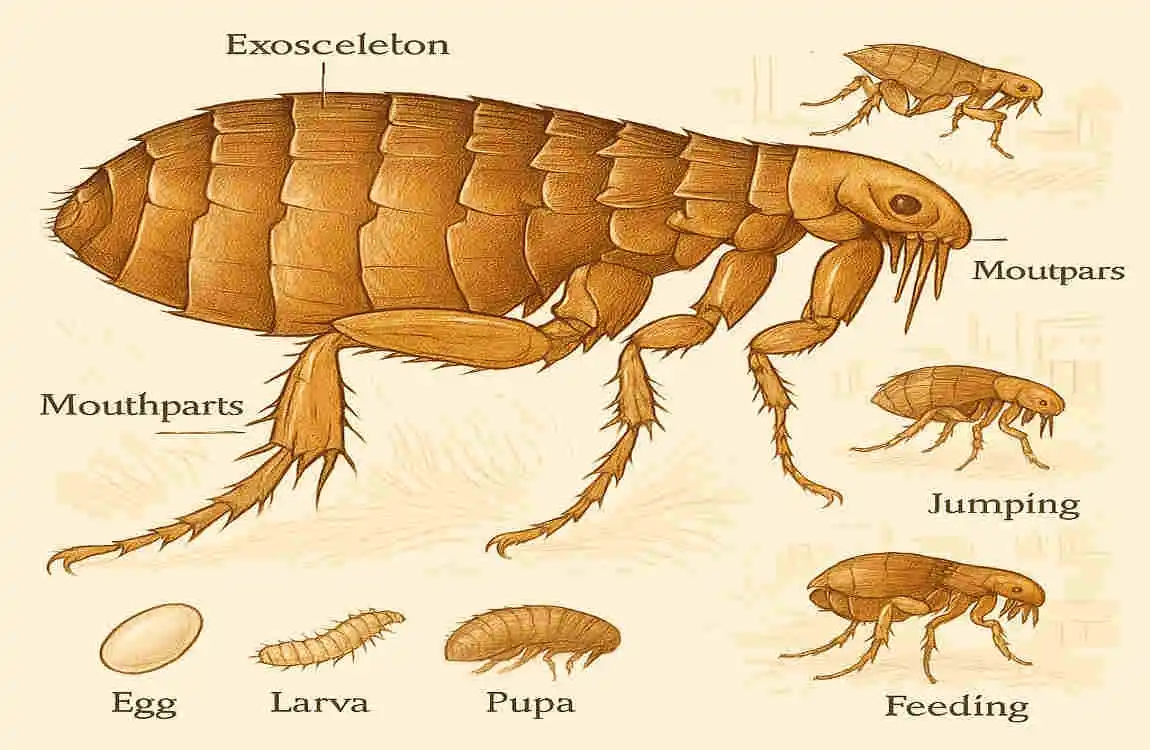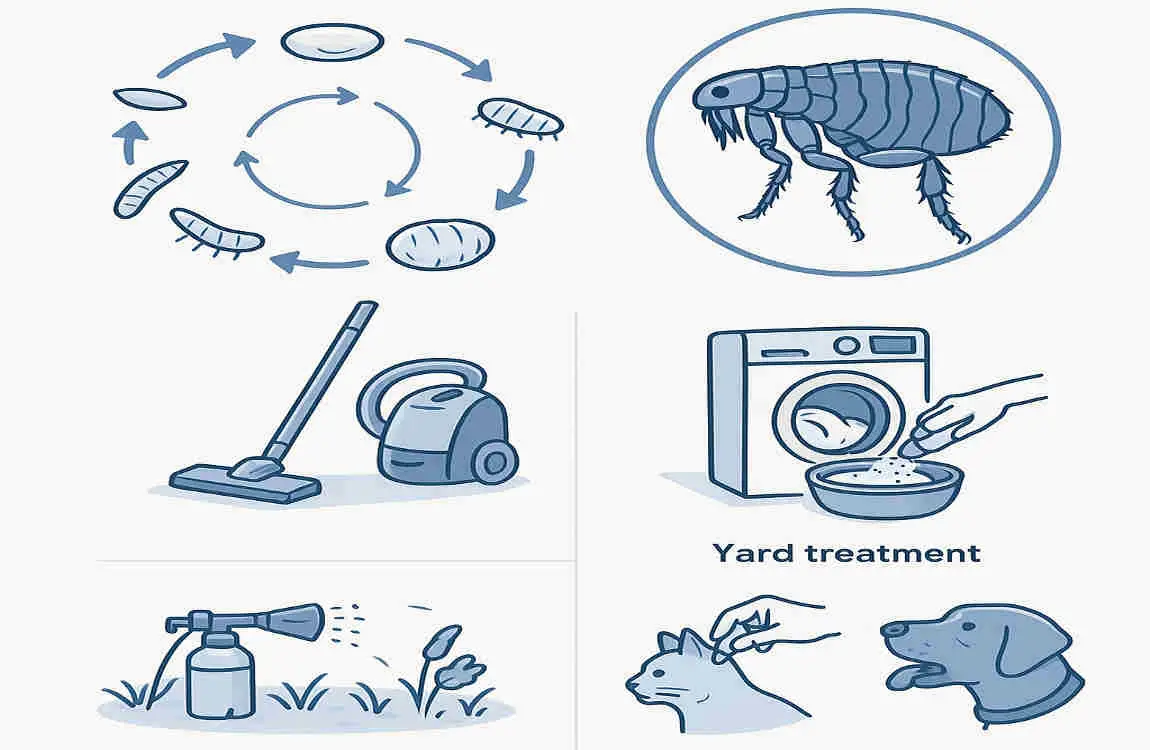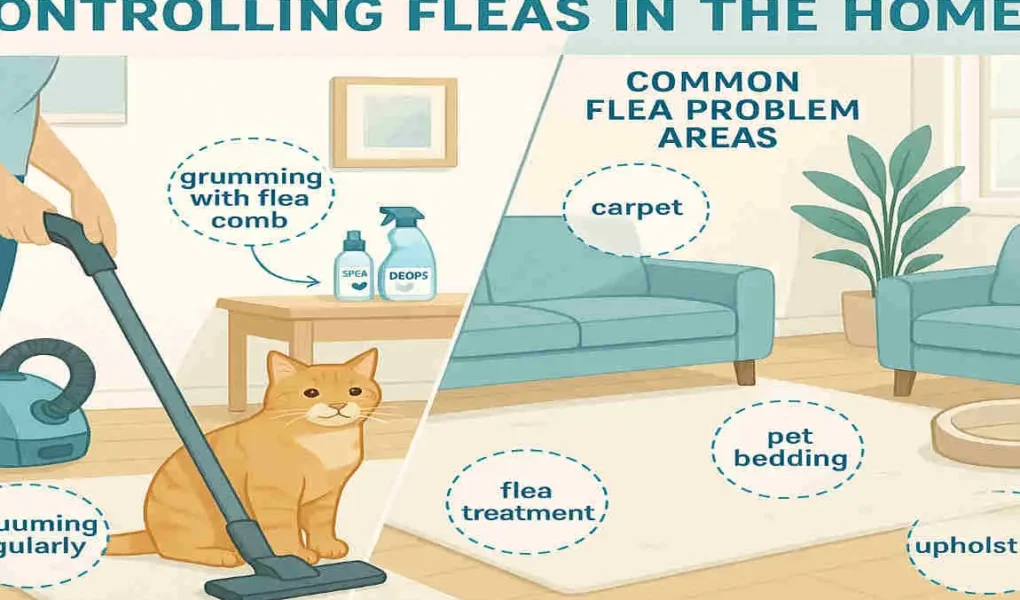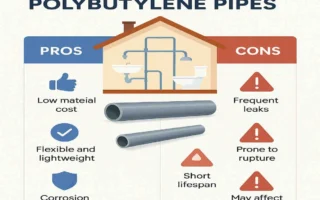Imagine this: One flea hitchhikes into your home on your dog’s fur, and before you know it, your entire living space is infested. That’s why understanding the speed of flea spread is crucial. We’ll break it down step by step, from flea basics to control strategies, so you can take action right away. Whether you’re a pet owner or just someone who wants a flea-free home, stick around – by the end, you’ll feel empowered to tackle this issue head-on.
Fleas thrive in warm, humid environments, and homes provide the perfect breeding ground. Did you know that a single female flea can lay up to 50 eggs a day? That’s how infestations explode so quickly.
Understanding Fleas: Biology and Behaviour

Fleas might seem like simple bugs, but their biology makes them masters of survival and rapid spread. If you’ve ever wondered how fast fleas spread in the house, it all starts with knowing what makes these critters tick. Let’s break it down in a way that’s easy to grasp.
What Are Fleas?
Fleas are tiny, wingless insects that feed on blood from animals and sometimes humans. The most common type you’ll find in homes is the cat flea, scientifically known as Ctenocephalides felis. Don’t let the name fool you – these fleas love dogs just as much as cats. They’re about 1-3 millimetres long, with flat bodies that enable them to slip easily through fur or fabric.
These pests have been around for ages, evolving to become expert jumpers. A flea can leap up to 150 times its own body length – that’s like you jumping over a skyscraper! This jumping ability enables them to move from one host to another, making them difficult to contain once they’re inside your home.
The Flea Life Cycle: A Quick Overview
To understand how fast fleas spread in the house, you need to know their life cycle. It has four stages: eggs, larvae, pupae, and adults. Each stage plays a role in how quickly an infestation grows.
Female fleas lay eggs right after feeding on blood. These eggs aren’t sticky, so they fall off the host and land on carpets, bedding, or cracks in the floor. That’s why your home environment becomes a flea nursery.
Larvae hatch from eggs and look like tiny worms. They avoid light and burrow into dark spots, feeding on organic debris like flea dirt (which is actually digested blood). Pupae are the cocoon stage, where the flea transforms into an adult. Adults emerge ready to jump on a host and start the cycle over.
How Fast Do Fleas Reproduce and Spread?
Here’s where it gets alarming: Fleas reproduce at an astonishingly rapid rate. A female flea can lay up to 50 eggs per day, and over her lifetime, that’s hundreds. Under ideal conditions – characterised by warm temperatures of 70-85°F and high humidity – eggs hatch in 2-14 days.
Larvae mature in 5-11 days, munching away in hidden spots. Pupae can remain dormant for days or even months, waiting for the right trigger, such as vibrations from footsteps, to emerge. The whole life cycle? It can wrap up in as little as two weeks if conditions are perfect.
Picture this: Start with 10 female fleas in your house. In 30 days, they could produce over a quarter of a million new fleas! That’s not an exaggeration – it’s based on real flea biology, as cited by Hartz pet care experts. This rapid reproduction is why infestations often seem to appear suddenly.
Conditions That Speed Up Flea Spread
Certain factors make fleas spread even faster in your home. Warmth and moisture are key – fleas love shady, humid areas, such as under furniture or in basements. If your house is carpeted or has lots of pet bedding, that’s prime real estate for them.
Fleas also move around effortlessly thanks to their jumping prowess. They can hop from your pet to the couch, then to you, spreading eggs everywhere. In a multi-pet household, this mobility can turn a small problem into a major one overnight.
Have you checked your home’s temperature lately? Keeping it cooler and drier can slow them down, but we’ll discuss control further later. For now, remember: understanding this biology is your first defence against how quickly fleas spread in the house.
How Fleas Spread in a Home

Now that we’ve covered flea basics, let’s talk about how these pests actually invade and take over your space. You might be surprised at how fast fleas spread in the house once they get a foothold. It’s not just about one flea; it’s about how they multiply and move.
Primary Sources of Fleas Indoors
Fleas don’t magically appear – they hitch a ride. Pets are the usual culprits, especially dogs and cats that roam outside. Wildlife like squirrels, raccoons, or stray animals can bring fleas near your home, and they sneak in through cracks or open doors.
Neighbours matter too. If the house next door has an infestation, fleas can migrate over, especially if you share yards. Even rodents like mice can carry fleas inside, turning your home into a flea highway.
Pathways of Flea Spread
Pets are the main carriers. A dog picks up fleas at the park, brings them home, and suddenly, eggs are dropping everywhere. However, people also play a role – fleas can hitchhike on your clothes, shoes, or bags after visiting an area infested with them.
Rodents add another layer. A mouse squeezes through a tiny hole, drops fleas, and boom – the spread begins. Once inside, fleas don’t stay put. They jump from host to host, laying eggs in new spots.
Favourite Hiding Spots and Movement
Fleas love cosy, hidden places. Carpets, pet bedding, furniture crevices, and even baseboards are among their favourites. They thrive in these areas because they’re dark and protected.
How do they move? Those powerful legs let them jump up to 18 inches vertically. From your dog’s back to the rug, then to the sofa – it’s a quick trip. In just 2-3 weeks, a few fleas can establish a full infestation, with eggs hatching and larvae hiding in various places.
Why Killing Adults Isn’t Enough
Here’s a key point: If you only target adult fleas, you’re missing the big picture. Eggs and larvae lurk in the environment, ready to hatch later. That’s why infestations rebound so fast. You need to address all stages to stop the spread.
Think about your own home – have you noticed more itching lately? Spotting these patterns early can prevent a small issue from exploding.
Signs of Flea Infestation in Your Home

Detecting fleas early is your best bet against a full-blown problem. Wondering how fast fleas spread in the house? It can happen in weeks, so knowing the signs helps you act quickly. Let’s go over the common indicators.
Pets often show the first clues. If your dog or cat is scratching excessively, especially around the tail or neck, fleas may be the cause. Look for signs of red, irritated skin or hair loss, which may be caused by excessive grooming.
Flea dirt is another telltale sign. These are small, dark specks that look like pepper on your pet’s fur or bedding. Wet it, and it turns red – that’s dried blood. You’ll also find it on surfaces, such as floors or furniture.
Visible fleas are obvious. Part your pet’s fur and check for tiny, fast-moving bugs. They might jump away, but if you see one, there are likely more.
Humans aren’t immune. Flea bites appear as itchy, red bumps, often in clusters on the ankles or legs. If family members are complaining of bites, investigate the situation.
Where to inspect? Focus on pet resting areas, carpets, and under beds. Use a flea comb on pets regularly – it’s a simple way to catch them early.
- Pet scratching or biting at the skin
- Dark flea dirt on fur or surfaces
- Jumping fleas on pets or furniture
- Itchy bites on humans
Comprehensive Flea Control Strategies

Controlling fleas requires a team effort – treating pets, cleaning indoors, and managing outdoors. Since fleas spread quickly in the house, a one-and-done approach won’t suffice. Let’s explore a multifaceted plan. You’ll need patience, as it might take weeks to fully eradicate them.
Treating Pets
Your pets are the primary target for fleas, so start here. Immediate treatment is key to breaking the cycle.
Use veterinarian-recommended products, such as flea collars, topical spot-on treatments, or oral medications, to control fleas. These kill adults and prevent eggs from hatching. Apply them regularly, even if no fleas are visible – prevention is easier than a cure.
Grooming helps, too. Brush your pet daily and use a flea comb to remove both eggs and adult fleas. Dip the comb in soapy water to drown them.
Consult your vet for tailored advice. They might suggest baths with flea shampoo. Remember, treating all pets in the house is essential – one untreated animal can reinfest everyone.
Indoor Flea Control
Inside your home, thorough cleaning is your weapon. Vacuum daily or every other day at first, focusing on carpets, under furniture, pet areas, and crevices. This sucks up eggs, larvae, and adults.
Empty the vacuum bag outside immediately to prevent the spread of the contamination. Wash pet bedding and linens in hot, soapy water every 2-3 weeks. Steam cleaning carpets kills all stages with heat – it’s super effective.
For extra help, use insecticides such as adulticides (to kill adult fleas) and insect growth regulators (IGRs) that prevent larvae from developing. Apply them safely, following labels.
Natural options? Try boric acid or diatomaceous earth sprinkled on carpets. These dehydrate fleas without harsh chemicals. Repeat treatments are necessary, as pupae can remain hidden for months.
Here’s a quick table comparing indoor methods:
Method: How It Works, Frequency Needed Pros Cons, Pros, Cons
Vacuuming Sucks up fleas and eggs Daily. Initially, it is Inexpensive, but it is Labour-intensive.
Steam Cleaning Kills with heat. Every 1-2 weeks. Effective at all stages. Requires equipment.
Insecticides target adults and growth. As per the label, Fast-acting. Chemical exposure risks.
Natural Powders: Dehydrates fleas. Weekly application, Pet-safe if food-grade, with Slower results.
Outdoor/Yard Flea Control
Don’t forget that outside yards can harbour fleas that reinvade your home.
Mow lawns short and remove debris, such as leaves or tall grass, where fleas hide. Treat pet-frequented areas with outdoor-safe sprays.
Keep wildlife away by securing trash and sealing entry points. Rodents carry fleas, making rodent control a crucial measure for preventing the spread of these pests.
Create flea-safe zones: Use gravel or mulch around play areas, and consider nematode sprays – these natural worms eat flea larvae.
Preventing Future Flea Infestations

You’ve controlled the current problem – now, how do you keep fleas away for good? Prevention is all about habits, especially since fleas spread fast in the house if given a chance.
Make year-round flea prevention a regular part of your pet’s routine. Use monthly treatments to stop hitchhikers from settling in.
Keep up cleaning: Vacuum pet areas weekly and wash bedding often. This disrupts any hidden eggs.
Monitor everyone after outdoor time. Check pets for fleas and watch for bites on family members.
Limit exposure by keeping pets indoors or supervised outside. Avoid areas with wildlife.
For tough cases, call professionals. Pest control services use advanced tools for persistent infestations.
Educate your family – teach kids to spot signs and avoid bringing fleas home. Simple steps like these maintain a flea-free zone.
Health Risks Associated with Fleas

Fleas aren’t just itchy – they pose real health threats. Understanding this motivates quick action on how fast fleas spread in the house.
Fleas carry diseases like plague, murine typhus, and cat scratch fever. Although rare, these can be transmitted to humans through bites from infected fleas or from infected pets.
Allergic reactions are common. Flea bites can cause dermatitis in pets, which can lead to infections. Humans might get severe itching or hives.
Protect your family by controlling fleas promptly. It’s not just comfort – it’s a matter of health.
How Fast Do Fleas Spread in a House? FAQ
Flea Reproduction Rate
- A single female flea can lay up to 25 eggs per day after her first blood meal, and she can live for about 7 days, producing around 175 eggs in her lifetime .
- Under optimal conditions (warm temperatures and high humidity), flea eggs can hatch in 2 to 14 days, and the larvae can mature into adults in as little as 20 days.
- This rapid life cycle means that fleas can multiply exponentially in a short period, leading to a noticeable infestation within a few weeks.
How Fleas Spread in a Home
- Fleas typically enter a home by hitching a ride on pets, clothing, or even used furniture .
- Once inside, fleas can infest carpets, bedding, furniture, and cracks in floors. They can jump from one area to another, spreading throughout the house quickly .
- Fleas are small and can be hard to notice at first, which is why infestations often seem to appear “overnight” .
Signs of a Flea Infestation
- Pets scratching excessively or showing signs of discomfort.
- Flea dirt (tiny black specks) on pet fur or bedding.
- Small red bites on humans, especially around the ankles.
- Spotting adult fleas jumping on pets, furniture, or carpets.
How to Stop Fleas from Spreading
- Treat Pets Immediately: Use veterinarian-recommended flea treatments, such as topical or oral medications, to kill fleas on your pets.
- Clean the Home Thoroughly: Vacuum daily to remove eggs, larvae, and adult fleas from carpets and furniture. Dispose of vacuum bags immediately.
- Use Flea Control Products: Apply flea sprays or powders to infested areas. In severe cases, consider using flea bombs or hiring professional pest control services.
- Wash Bedding and Fabrics: Wash pet bedding, human bedding, and any fabrics that may have come into contact with fleas in hot water.




